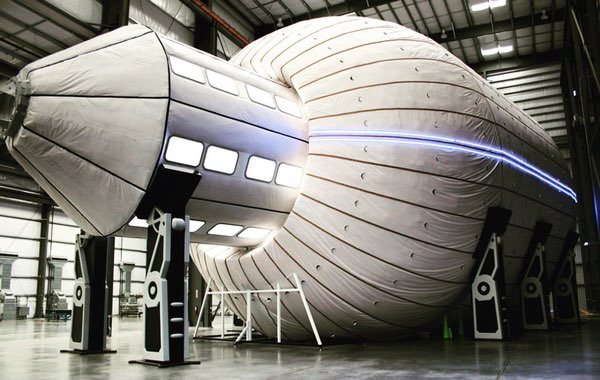Mars lodging and ground transportationby Sam Dinkin
|
| As odd as it sounds, it may be more economical to simply leave some of the ITS spacecraft on Mars as habitation units. |
Along with the hardware, Musk also announced in his recent speech at the International Astronautical Congress in Guadalajara, Mexico, an ambitious price target of $200,000 to Mars round trip per person and a $140,000 per ton ($154 per kilogram) cost of cargo delivered to the surface of Mars. While it’s not clear if this includes food or luggage, the cargo price certainly low enough me to pay the luggage overage fee for at least a whole ton of luggage when I go. One thing appears clear: the ticket price does not include lodging for those who wish to remain after the ITS spacecraft departs.
Bigelow Aerospace offers two options for habitation units. A Bigelow B330 weighing 22,000 kilograms would cost $3.4 million to transport at the target price of cargo. With a volume of 330 cubic meters, several of them can house six Mars arrivals in approximately the same comfort as the International Space Station (932 cubic meters), which has a capacity of six people.
Given Musk’s big-gulp size booster and dry launch with a cargo capacity of 408 tonnes, it might be better to send B2100 modules weighing 70,000 to 100,000 kilograms, which each have a capacity of 16 people. This would have transportation costs of $15.4 million/module. For initial colonists, that would mean luggage charges of about another $1 million for a bunkhouse 2100 or $1.7 million each for double occupancy 330. In his book Bigelow Aerospace, Erik Seedhouse predicts the cost of a BA330 as $125 million. The cost of the BA2100, outside of delivery costs, might be in line with its approximately five times as much mass. So to buy the house to take with you will cost about $17 million per person for bunkhouse living or $63 million per person for a double. I’m guessing Bigelow will be able to offer a volume discount, and there will be plenty of other options in due course, if Musk makes substantial progress on achieving a Mars population of one million people in 50 to 110 years.
Visitors will not need to own, but can presumably rent for a couple of years. Using Musk’s favored five-percent discount rate (which I hope to analyze in a subsequent article), initial visitors might pay $3,400 per Mars night for their bunk, or about $2.3 million for a one-year stay (maid service not included.)
| Maybe SpaceX will throw in a Tesla as a deal sweetener to go with your share of the ITS spacecraft. |
As odd as it sounds, it may be more economical to simply leave some of the ITS spacecraft on Mars as habitation units. (It wouldn’t sound odd to Bob Zubrin, whose Mars Direct plan included leaving habitation modules.) At a cost of $200 million new, the ITS spacecraft could house 100 travelers and come complete with a methane plant, solar panels, environmental systems, a big window, and a bunch of rocket engines that could be salvaged and reused for local transport or shipped back to Earth as cargo. If we assume rocket engines are two-thirds of the cost of the ITS booster (using one estimate that 65 percent of a booster’s cost is the propulsion), that’s $3.6 million per engine, and the ITS spacecraft has nine. So if you buy new and you sell back the engines at Mars, you might be able to own a slightly used former spacecraft to share with 99 of your best friends for about $1.7 million a person. That sounds like a much better deal than the B2100 and, unlike it, the ITS spacecraft transports itself to Mars and doesn’t need to be unpacked.
A typical family of four might want an electric car to travel around Mars. A Tesla Model 3 has a curb weight of 1,800 kilograms. So plan on another 450 kilograms of luggage ($70,000 per person) and the cost of the car ($9,000 per person). Maybe SpaceX will throw it in as a deal sweetener to go with your share of the ITS spacecraft.
